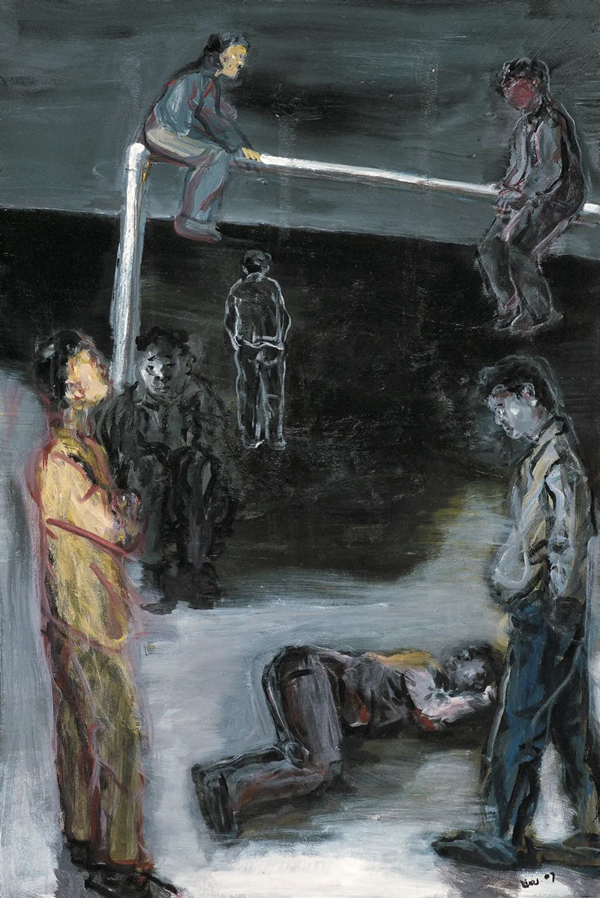访谈 | 黎旭个展“不安之书”
时间:2020/8/3 16:05:24 来源:FUNSPACE ART
2020年7月25日起,黎旭个展“不安之书”(The Book of Disquiet)在Funspace Gallery线上展厅举行,展览展出他的部分油画作品,由胡凌远担任策展人。展览持续到8月31日。
作为艺术家黎旭艺术生涯里的首个意大利个展,策展人胡凌远基于他的绘画语言与艺术哲学,针对性地挑选了16件创作于2008年至2015年的绘画作品。这批作品无疑代表了黎旭艺术生涯里的一个重要时期——其绘画语言的确定。作为一名成熟的艺术家,再次回顾三十多年来的从艺经历与遭遇的艺术困境,不禁有所感慨。就如他所说的,每个艺术家都会经历的西西弗斯式的痛苦。不可避免,创作于这段时间的这批作品也属于这个状态之下。他认为在不断推翻,重构后创作的这批作品所产生截然不同的效果来自于诸多的不确定性。这种不确定性不是来自理性与逻辑,往往是它的反面。
艺术家所经历的这种状态与感受也存在于几乎每个普通个体身上。思考与逃避都在一念之间,而一切疑惑与意义都在自我探索之中。黎旭说:“在现实中未知让人恐惧,但似乎绘画的乐趣与秘密却深藏其中”。

黎旭
1970年出生于中国内蒙古,目前居住工作于中国北京和美国纽约。1997年毕业于天津美术学院油画系;2004年毕业于中央美术学院油画系第四工作室研究生班;2012 年毕业于中央美术学院,获得油画专业博士学位。博士研究方向:中国油画与传统文化研究 ;博士论文《自由观看 —汉代画像艺术的空间观》 由中国国家图书馆收录 。
黎旭的作品已在国内外不同艺术机构展出,包括中国美术馆、今日美术馆、中央美术学院美术馆、浙江美术馆、中华世纪坛、巴黎大皇宫、国会宫美术馆、开罗国家艺术厅等。目前,他的作品被浙江美术馆、中华世纪坛、元典美术馆、环铁艺术时代美术馆、Vest Agder Museum等艺术机构收藏。
Bio
Li Xu was born in 1970 in Inner Mongolia, China. Now he lives and works in Beijing, China, and New York, USA. Li Xu graduated from Oil Painting Department of Tianjin Academy of Fine Arts in 1997; he graduated from the fourth studio of the Oil Painting Department of the Central Academy of Fine Arts in 2004; he received doctor’s degree in Oil Painting from the Central Academy of Fine Art in 2012. His doctoral research interests are Research on Chinese Oil Painting and Traditional Culture; doctoral thesis Free Viewing: The Space Concept of Portrait Art in Han Dynasty has been collected by National Library of China.
Li Xu’s works have exhibited different art institutes at home and abroad, including National Art Museum of China、Today Art Museum、 CAFA Art Museum、 Zhejiang Art Museum、 China Millennium Monument、Congress Palace Museum、 Cairo and more. Currently, his works have been collected by Zhejiang Art Museum、China Millennium Monument、Yuan Art MuseumGrand Palais、 Huan Tie Times Art Museum、 Vest Agder Museum and other art institutions.

对话黎旭
你的艺术创作受什么影响比较大?
What has influenced your artistic creation?
黎旭:影响最大的当然是美术史,可以说是整个美术史。当然美术史中我是有个人偏好和兴趣的,对中国汉唐时期的艺术、西方的后印象派之后的艺术研究更多一些,对我的影响更多的是艺术语言层面的。另外一个就是当代哲学对我的影响非常大,像存在主义哲学,萨特、海德格尔以及现在西方当代的一些哲学家比如让.鲍德里亚、哈贝马斯等,这方面的影响主要是思维方式的影响。还有就是我个人的生活经历、体验,对当代社会的观察、看法和思考。作为中国70年代初出生的人,经历了中国巨大变革的过程,不惑之年又有机会生活在美国,体会到迥然不同的社会形态、政治形态,这些都会在我的作品中留下印痕。
The most influential thing is absolutely the art history. You can say the whole of art history. Of course, I also have my own preference and interests in art histories. I do more research on Chinese art during the Han and Tang Dynasties and the post-Impressionist art in the West. They have more impact on my artistic language level. In addition, contemporary philosophy has huge effect on me, like existentialist philosophy, Sartre, Heidegger, and some contemporary western philosophers like Jean Baudrillard and Habermas, which is mainly the influence of thinking way. There are also my personal life experiences, observations, opinions, and thinking about contemporary society. As a person born in China in the early 1970s, I have experienced the process of great change in China, and I have had the opportunity to live in the United States when I was in my 40s. I have experienced very different social and political forms which will leave a trace on my work.
你平时的工作状态与工作方法?
What is your working status or approach?
黎旭:我工作时喜欢把自己置于放空的状态,让自己可以即兴发挥,强调随机性或者偶发性。当然我始终有一个大的创作方向,会有一个相对具体的想法,以及最终应该呈现一个什么样的结果。在具体过程中比较即兴,看有哪些出发点激发我的兴趣,我会把这个点快速地放到我的画布上。这有些像老子的“一生二,二生三,三生万物”,无中生有。当然最后发展成什么样子,自己也是很难预料。但最后结果会比较有意思,往往不见得和最早想呈现的一样,有可能表达的更丰富,或挖掘了另外的想法。
I prefer to put myself in a state of emptiness when I work, allowing myself to improvise, emphasizing randomness or contingency. Of course, I always have a big creative direction and a comparatively specific conception of what the final result should be. In the specific process of improvisation in order to see what starting points stimulate my interests, I will quickly put it on my canvas. It is as Laozi said, “one produced two, two produced three, and three produced the myriad things.” Out of nothing. It is difficult for me to predict what the final development will be. But the end result can be impressive, even if it the original intention is not so much present. It may be more expressive, or explore other ideas.
这次展览中,人体一直是你表现作品时最明显特征之一。为什么会倾向于选择人体这一形态?
The human body is the most obvious features in this show. Why would you prefer to choose it?
黎旭:我确实是画了很多人体,有单人体、双人体甚至多人体。这批作品呢,我当时是有一个思考,我希望把所有时间性、时代感,或者能提供具体身份的这种信息以及因素把它消除掉,而只呈现或表达人本身(赤裸的),存在的这种状态。尽量把我认为不是很重要的东西,给它单纯化。这是当时创作的一个明确的想法。去掉时代性与指向性,回归人的本质。
I did draw many human bodies, single, double, even multiple. I have a thought in this batch of works. I wish to eliminate all the sense of time and contemporaneity, or the information and factors that provide a specific identity, to present or express only the state of being (naked). I try to simplify the unimportant things, which is a definite idea at that time. Get rid of The Times and directly return to human nature.
为什么会有去时代性的想法?
Why do you have the de-epochal idea?
黎旭:这个想法的来源是我认识到人是有共性的。之前有过多次去欧洲进行艺术交流的活动,我发现不同的文化、人种、国家表面上好像差异很大,但是人性其实是一致的。甚至包括无论是古代的人,还是现代的人,作为人有很多共性。我其实想表达这种共性。所以我会有意的(在创作中)把具体身份的因素去除掉,让背景尽量单纯,而仅仅指向人本身。我为什么画人体呢?就是想把衣服也去除掉,能辨识身份的东西都去除掉,表达最直接、最赤裸的人性这么一个朴素的想法。
This idea stems from my understanding that people have something in common. I have been to Europe for artistic exchange many times before. I found that different culture, races and countries seem to be extremely different on the surface, but human nature is actually the same. Even both ancient and modern people have a lot in common as human beings. I really want to express this commonality. Therefore, I will intentionally remove the specific identity factors and make the background as simple as possible and only point to the person. Why do I depict the human body? It’s about removing clothes and identity, expressing the simple conception of the most direct and naked human nature.
你提到每个艺术家都经历过自己的西西弗斯。那对于正处于这种状态下的青年艺术家你有什么建议?
You mentioned that every artist is experienced their own “Sisyphus”. Do you have any suggestions to the young artists who are in this kind of status?
黎旭:应该是每个艺术家面临最大的困难与敌人其实是自己,是如何面对自己(的创作)。这是每个艺术家终生需要思考的问题。所以我说每个艺术家面临问题,是所谓西西弗斯式的困境,是想表达这个意思。在这个过程中,你不断地碰到问题,解决问题,最终可能会获得一个很好的结果;当然,也可能会失败。关键是在这个过程中要学会坚持,学会解决的方法,这是最重要的。
It should be that every artist faces the greatest trouble and the enemy is actually themselves. It’s how to face his own creation. This is what every artist needs to think about all his life. Thus, I talked about the problems encountered by the artist, which is a Sisyphus dilemma. In this process, you will continuously meet problems, deal with them, and finally get a better consequence. Of course, it may fail. In this process, the key is to learn to persevere and learn how to solve it, which are the most significant.

在那里
布面油画
40x60cm
2012

黄色灯光 布面油画 40x60cm
2012

FUNSPACE ART GALLERY成立于2015年,是一个致力于当代艺术创造力的综合机构,总部设立在意大利罗马。我们不仅是保护和展示艺术作品的空间,而且是实验和文化创新的实验室,研究和生产这个时代的美学内容。
Funspace Art线上虚拟展厅将携手多位当代艺术家为大家带来全新展览。
版权与免责声明:
【声明】本文转载自其它网络媒体,版权归原网站及作者所有;本站发表之图文,均出于非商业性的文化交流和大众鉴赏目的,并不代表赞同其观点和对其真实性负责。如果发现有涉嫌抄袭或不良信息内容,请您告知(电话:17712620144,QQ:476944718,邮件:476944718@qq.com),我们会在第一时间删除。版权所有 2000-2020 上海麟驾艺术品信息有限公司
Copyright 2000-2020 Cnarts.net Incorporated. All rights reserved

|
 |
 |
 |
 |
沪公网安备 31010102006431号 |



